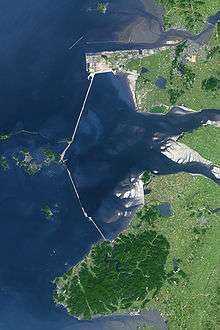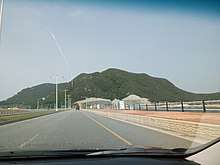Saemangeum Seawall
The Saemangeum Seawall, located on the southwest coast of the Korean peninsula, is the world's longest man-made dyke, measuring 33 kilometres (21 mi). It runs between two headlands, and separates the Yellow Sea and the former Saemangeum estuary.

| Saemangeum Seawall | |
 Picture taken by NASA in October 2006. The city on top of the picture is Gunsan City, and the below is Buan County. | |
| Korean name | |
|---|---|
| Hangul | 새만금 방조제 |
| Hanja | 새萬金防潮堤 |
| Revised Romanization | Saeman(-)geum bangjoje |
| McCune–Reischauer | Saeman'gŭm pangjoje |
In 1991, the South Korean government announced that a dyke would be constructed to link three headlands just south of the South Korean industrial port city of Gunsan, 270 kilometres (168 mi) southwest of Seoul, to create 400 square kilometres (150 sq mi) of farmland and a freshwater reservoir. Since then, the government has spent nearly 2 trillion won (1.82 billion USD) on construction of the dyke, with another 220 billion won (199.89 million USD) budgeted on strengthening the dyke and a further 1.31 trillion won (1.19 billion USD) to transform the tidal flats into arable land and the reservoir. The average width of the sea wall/earth dam is 290 metres (950 ft) (it is 535 metres (1,755 ft) at its widest) and the average height is 36 metres (118 ft) (54 metres (177 ft) at its highest).[1]
The construction of the Saemangeum Seawall has caused controversy from the moment it was announced as environmental groups protested against the impact of the dike on the local environment. Supreme Court challenges in 1999 and 2005 led to temporary production stoppages but ultimately failed to stop the project. Major construction was completed in April 2006, with the seawall 500 metres (1,600 ft) longer than the Afsluitdijk in the IJsselmeer, the Netherlands, previously the longest seawall-dyke in the world.
With remaining minor construction and inspection finished, the seawall was officially open to the public on 27 April 2010. Then South Korean president Lee Myung Bak commented that Saemangeum would be "the kernel and the gateway of South Korea's west coast industrial belt", and is "another effort by us for low-carbon and green growth, along with the four-rivers project".[2] A ceremony was held in Saemangeum the same day, with cabinet officials, politicians, and delegates from other countries.
A floating solar PV plant of 2.1 GW capacity is planned using the coastal reservoir area of the Saemangeum Seawall.[3]
Composition


The road on Saemangeum Seawall with the length of 33 km, connects Buan County to Gunsan is a part of National Route 77.
IS: Intersection, IC: Interchange
| Name[4] | Hangul name | Connection | Location | Note | |
|---|---|---|---|---|---|
| Saemangeum IS | 새만금 교차로 | National Route 30 (Byeonsan-ro) |
Buan County | Byeonsan-myeon | |
| Saemangeum Seawall (1st section) | 새만금 방조제 (1호) | 4.7 km long | |||
| Garyeok-do Park (Garyeok Service Area) |
가력도공원 (가력휴게소) |
||||
| Garyeok Drain Gate | 가력배수갑문 | ||||
| Saemangeum Seawall (2nd section) | 새만금 방조제 (2호) | Gimje | Jinbong-myeon | 9.9 km long | |
| Sinsi Drain Gate | 신시배수갑문 | Gunsan | Okdo-myeon | ||
| Sinsi Tunnel | 신시터널 | Approximately 70m | |||
| Sinsi 1 IS | 신시1교차로 | National Route 4 (Gogunsan-ro) |
National Route 4 overlap | ||
| Saemangeum Seawall (3rd section) | 새만금 방조제 (3호) | National Route 4 overlap 2.7 km long | |||
| Yami-do | 야미도 | National Route 4 overlap 11.4 km long | |||
| Saemangeum Seawall (4th section) | 새만금 방조제 (4호) | ||||
| Soryong-dong | |||||
| Sinsi-do Entrance IS | 신시도입구삼거리 | Bieung-ro, Saemangeumbuk-ro | |||
See also
- Saemangeum
- Sihwa Lake Tidal Power Station
- Environment of South Korea
- The Four Major Rivers Restoration Project
- Kalpasar Project
References
- "Saemangeum: a new global city". Retrieved 17 August 2018.
- Lee, Chidong (27 April 2010), "Lee says Saemangeum tidal flat to change S. Korea's history", Yonhap News
- "South Korea to Build World's Largest Floating Solar Power Project". Retrieved 3 August 2019.
- Intersection and interchange are also included , as well as buildings and facilities in the surrounding area
- "Saemangum seawall completed", The Korea Herald, 22 April 2006, Seoul.
- Google Earth view
- Google Maps view
- Article in New York Review of Books Mentions Saemangeum Seawall as prime example of bird habitat loss